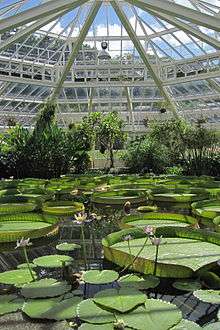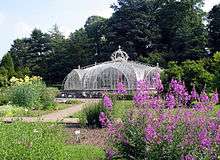Botanic Garden Meise
.jpg) | |
 Location within Belgium | |
| Established | 1840 |
|---|---|
| Location | Nieuwelaan 38, Meise, Flemish Brabant, Belgium |
| Coordinates | 50°55′42″N 4°19′39″E / 50.928358°N 4.327383°E |
| Director | Dr. Steven Dessein |
| Owner |
Flemish Community (since 2014) Belgian State (until 2013) |
| Website | www.botanicgarden.be |
The Botanic Garden Meise (Dutch: Plantentuin Meise, French: Jardin botanique Meise; until 2014 called the National Botanic Garden of Belgium (Dutch: Nationale Plantentuin van België, French: Jardin Botanique National de Belgique)) is located in the grounds of Bouchout Castle in the town of Meise, just north of Brussels in the province of Flemish Brabant. It is one of the largest botanical gardens in the world with an extensive collection of living plants in addition to a herbarium of over 3 million specimens. The current garden was established in 1958 after it moved from the centre of Brussels; the former site is now the Botanical Garden of Brussels. Researchers at the garden conduct research particularly on Belgian and African plants.
The Botanic Garden contains about 18,000 plant species—about 6% of all known plant species of the world. Half are in greenhouses, the other half, including cultivated and indigenous plants, are outdoors. The gardens are grouped around the castle and lake of the Bouchout domain.
The mission statement of the Botanic Garden Meise specifies the increasing and spreading "the knowledge of plants" and contributions to "the conservation of biodiversity."
The Botanic Garden was property of the Belgian federal government, but after several years of negotiations it was eventually transferred to the Flemish Community (Flanders) effective 1 January 2014. The French Community still has its own employees and representation in the board of directors. The plants, library, etc. remain property of the federal State but given as commodate to the Flemish Community.
History
Establishment in Brussels
The first botanic garden in Brussels belonged to the Ecole Centrale du Département de la Dyle that was created during the French rule of Belgium at the end of the 18th century. Due to their costs, those French schools were soon dropped and some municipalities, including the City of Brussels, took over the garden that was about to be abandoned. In 1815, Belgium became part of the United Kingdom of the Netherlands. Around the same period, the maintenance costs of the garden were regarded as too high by the city administration. A group of local bourgeois decided to create a new kind of botanical garden in Brussels. At the time the bourgeoisie was the new leading-class and since companies were popular financing method the garden was created as a company. The creators thought it would be their contribution to the city's reputation. Although it was rooted on a private enterprise, it was also supposed to be a national institution dedicated to science.


Both the City and the Home Office supported it financially. But, the Independence of Belgium (1830-1831) was detrimental to the Dutch-born institution: it was regarded as orangist, as a mere playground for the local elites, and as not useful for the country's agriculture, among other critiques. From then on, the garden would have to battle to survive. The state and the city did not want to support it anymore unless it proved useful to the whole country, so the Garden was obliged to develop its commercial activities. It sold plants by the thousands, and created several money-consuming attractions and events for the local élite, like aquaria, a dance room, fairs, a fish nursery, concerts etc. In the 1860s, the aging buildings required renovation. The board of the Society of Horticulture tried to raise the money, but the costs were just too high for the company. In 1870, the Belgian Government took over the company. The National Botanic Garden was created in the very same year. Barthélemy Dumortier (1797-1878), a Belgian politician and botanist, had played a major role in this process. He wanted a “Belgian Kew” to be created in the capital of Belgium, that is to say a botanical garden dedicated to taxonomy. That is why, some months before the garden was bought by the state, the Belgian Government had purchased the famous von Martius Herbarium that was held in Munich. So, in 1870, Belgium had a great herbarium and an appropriate building. This was the dawn of a new era for Belgian botany.
Move to Meise
In 1927, just after the death of empress Charlotte, it was proposed to set up the National Botanical Garden at the Bouchout Domain. It took until 1937 before the final decision was made and major constructions were started. To the South-East of Bouchout Castle, the "Palace of the Plants" was built, which consists of a number of greenhouses. More to the South-West of the castle, the Victoria Balet greenhouse was placed. This greenhouse was designed in 1853 by Alfonse Balat and transported from its original location at the Botanical Garden of Brussels.
During the second world war, Bouchout Castle was occupied by the German forces and the domain altered into a fortress. Next to the Palace of Plants, six baracks were placed and concrete defenses were erected. The court of honour of Bouchout Castle was used to store ammunition, while artillery defenses were placed at the borders of the domain. The last German soldiers left Bouchout domain at 3 September 1944. Just a few days later, the Allied Forces arrived who used it as a training location, while stationing about 200 vehicles at the domain. At 29 November 1944, a bomb exploded at the Western part of the parc destroying the windows of Bouchout Castle. A second bomb exploded at 2 December nearby the adjacent Hoogvorst Castle, causing its complete destruction.
Later history
| Wikimedia Commons has media related to National Botanic Garden of Belgium. |